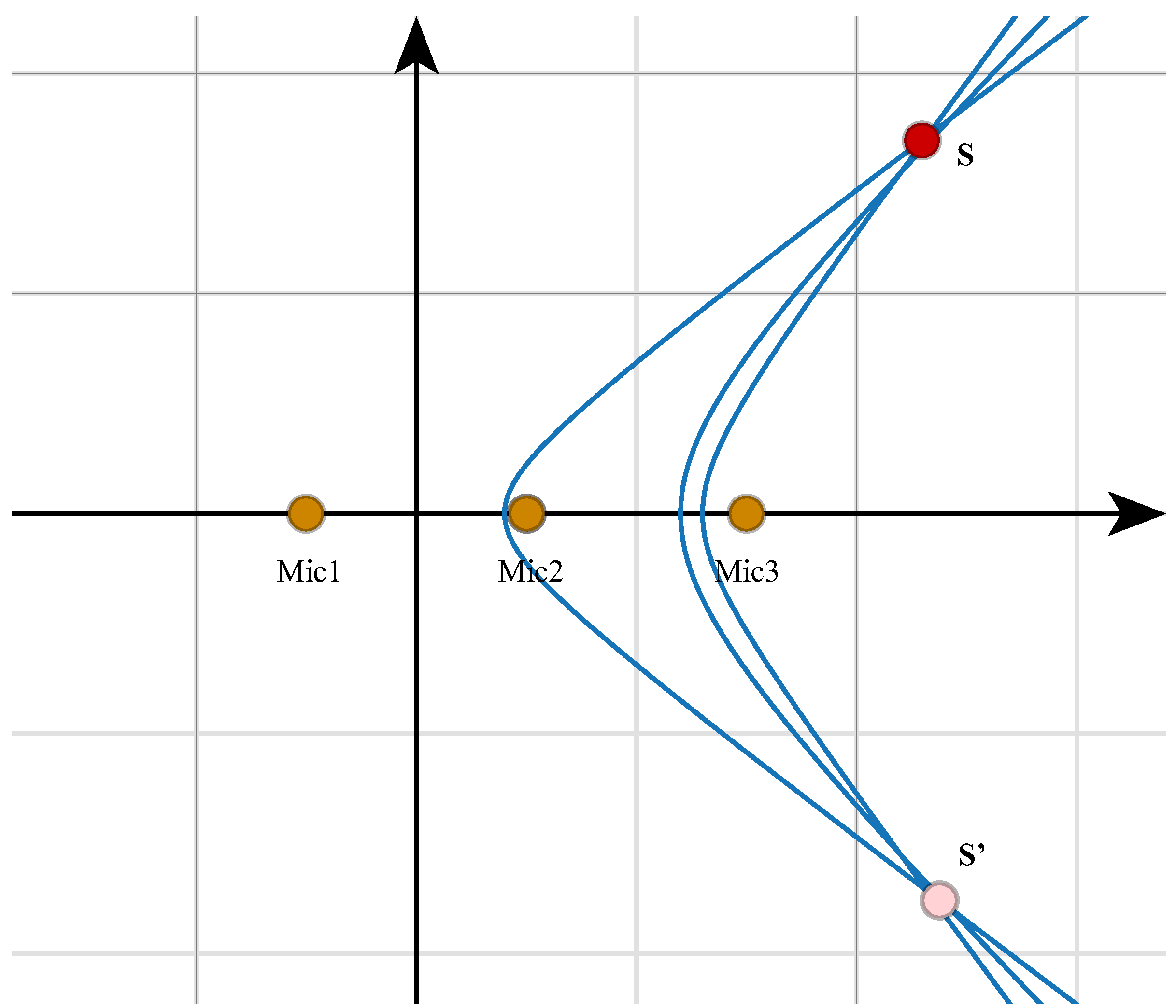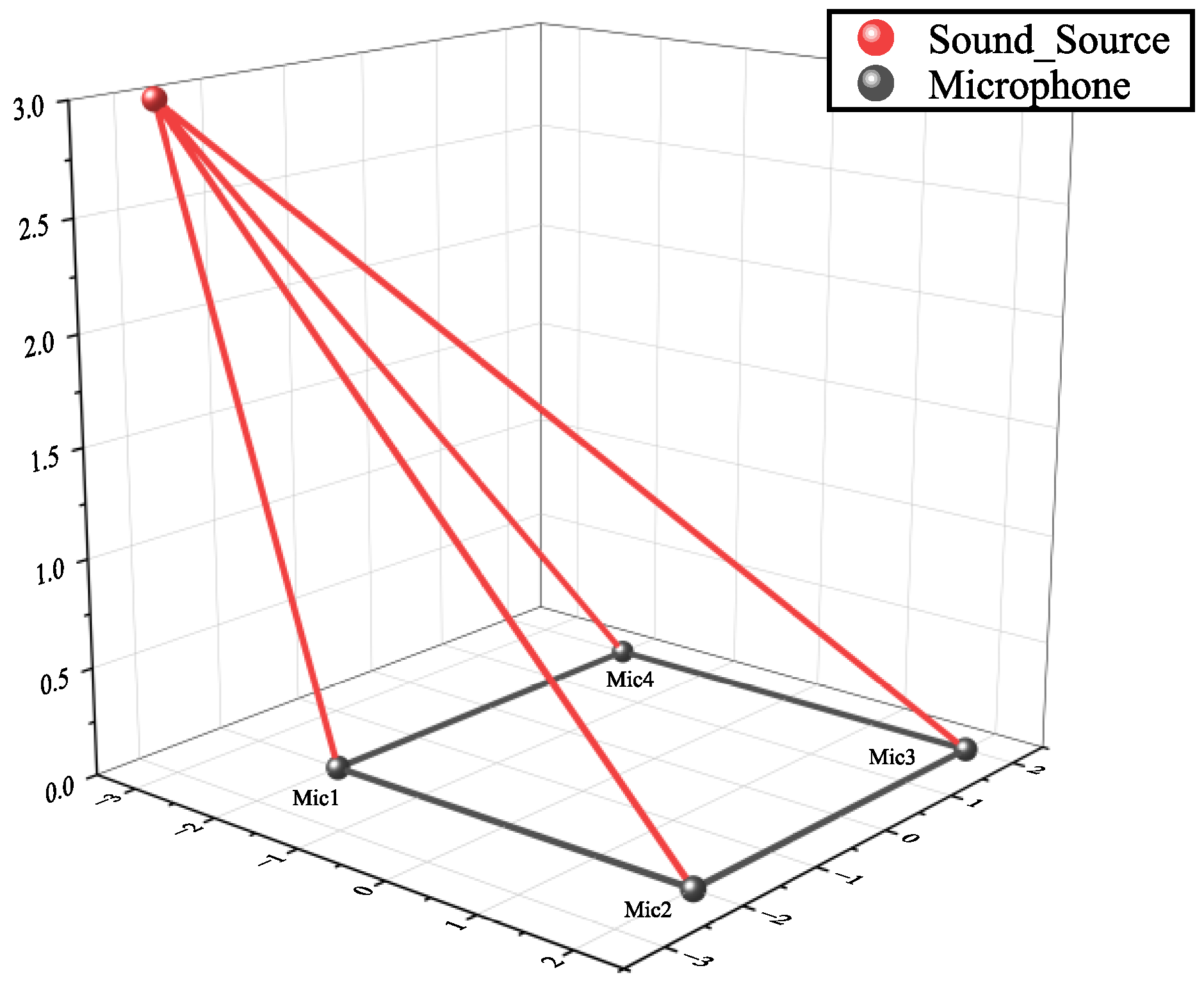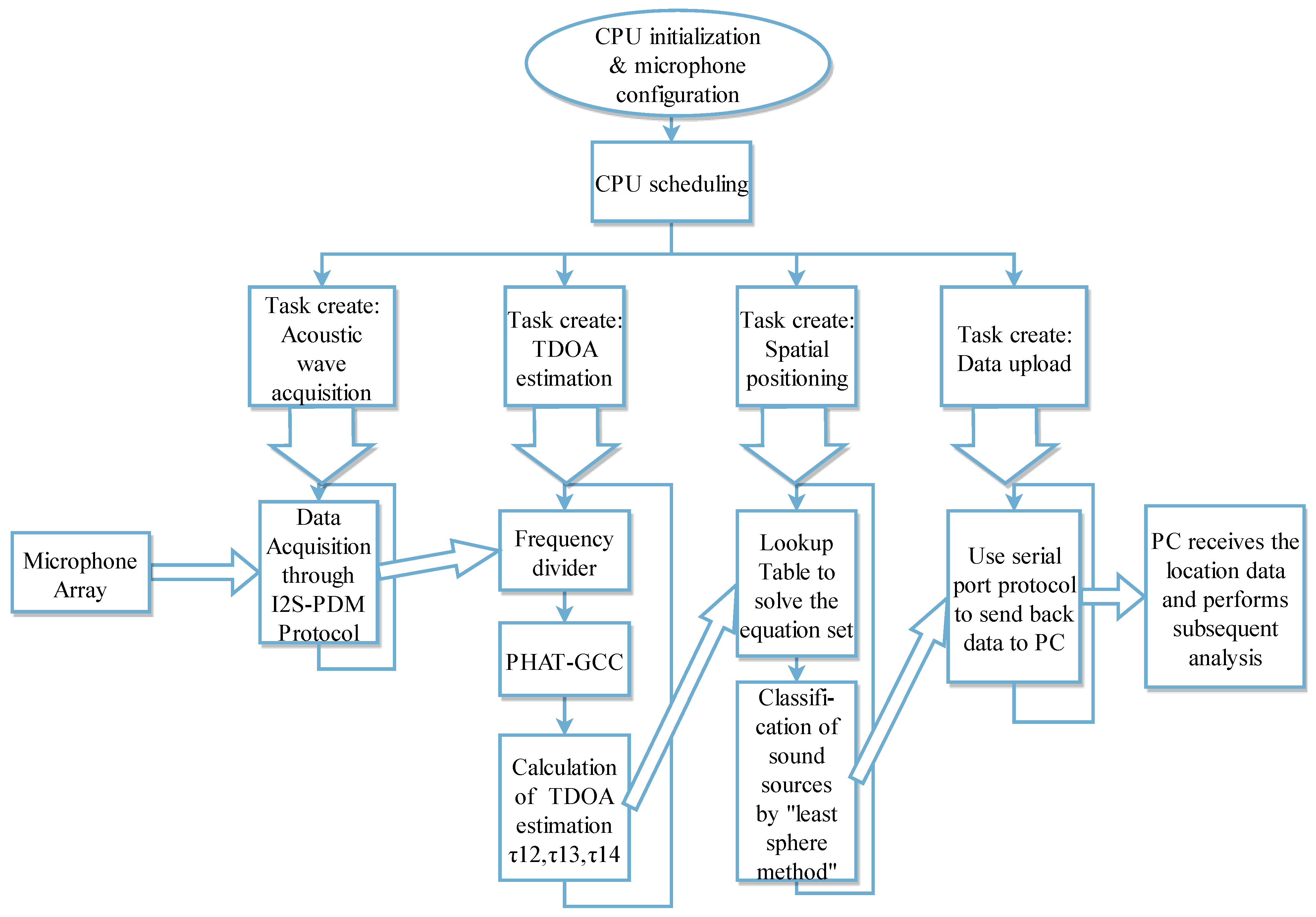A Sound Source Localization Method Based on Frequency Divider and Time Difference of Arrival
Abstract
1. Introduction
2. TDOA Estimation Algorithm and Improvement Algorithm of Frequency Divider
2.1. GCC TDOA Estimation Algorithm
2.2. Data Pre-Processing Based on Frequency Divider
2.3. Geometric Localization Based on TDOA Estimation
2.4. Multi-Frequency Coordinates and Multi-Source Data Integration Using the “Minimum Sphere Method”
3. Algorithm Feasibility Verification and Lightweight System Design Implementation
3.1. Semi-Spatial Positioning
3.2. Space Positioning
4. Analysis of System Test Results
4.1. Test Method
4.2. Accuracy Metrics
4.3. Experimental Results
5. Conclusions
Author Contributions
Funding
Institutional Review Board Statement
Informed Consent Statement
Data Availability Statement
Conflicts of Interest
Appendix A
| No. | Components | Quantity | Notes |
|---|---|---|---|
| BOOT,EN | Micro-action buttons | 2 | |
| C1, C2, C8, C9, C10, C11, C12 | 100 nF | 7 | 0603 |
| C3 | 22 pF | 1 | 0603 |
| C4 | 1 uF | 1 | 0603 |
| C5 | 4.7 uF | 1 | 0603 |
| C6, C7 | 10 uF | 2 | A-type tantalum capacitors |
| D1 | SS14L | 1 | |
| H1, H2, H3 | HDM Joints | 3 | 2P, 3P, 4P |
| L1 | 10 uH | 1 | |
| LED1 | WS2812B | 1 | RGB-LED indicator |
| R1, R2, R3, R5 | 100 kΩ | 4 | 0603 |
| R4 | 200 Ω | 1 | 0603 |
| R6, R7 | 10 kΩ | 2 | 0603 |
| U1 | LM1117 | 1 | LDO |
| U2 | TPS61040 | 1 | Boost Management |
| U3, U4, U5, U6 | SPU0410LR5H-QB | 4 | MEMS |
| U7 | ESP32-WROOM-32E | 1 | MCU |
References
- Ikoma, N.; Osamu, T.; Kawano, H.; Maeda, H. Tracking of 3D sound source location by particle filter with TDOA and signal power ratio. In Proceedings of the 2009 ICCAS-SICE, Fukuoka, Japan, 18–21 August 2009; pp. 1374–1377. [Google Scholar]
- Merino-Martinez, R.; Sijtsma, P.; Snellen, M.; Ahlefeldt, T.; Antoni, J.; Bahr, C.J.; Blacodon, D.; Ernst, D.; Finez, A.; Funke, S.; et al. A review of acoustic imaging methods using phased microphone arrays. CEAS Aeronaut. J. 2019, 10, 197–230. [Google Scholar] [CrossRef]
- Li, Q.; Chen, B.; Yang, M. Improved Two-Step Constrained Total Least-Squares TDOA Localization Algorithm Based on the Alternating Direction Method of Multipliers. IEEE Sens. J. 2020, 20, 13666–13673. [Google Scholar] [CrossRef]
- Jin, D.; Yin, F.; Fritsche, C.; Gustafsson, F.; Zoubir, A.M. Bayesian Cooperative Localization Using Received Signal Strength with Unknown Path Loss Exponent: Message Passing Approaches. IEEE Trans. Signal Process. 2020, 68, 1120–1135. [Google Scholar] [CrossRef]
- You, Y.; Wu, C. Indoor Positioning System With Cellular Network Assistance Based on Received Signal Strength Indication of Beacon. IEEE Access 2020, 8, 6691–6703. [Google Scholar] [CrossRef]
- Li, B.; Zhao, K.; Shen, X. Dilution of Precision in Positioning Systems Using Both Angle of Arrival and Time of Arrival Measurements. IEEE Access 2020, 8, 192506–192516. [Google Scholar] [CrossRef]
- Gabbrielli, A.; Bordoy, J.; Xiong, W.; Fischer, G.K.; Schaechtle, T.; Wendeberg, J.; Höflinger, F.; Schindelhauer, C.; Rupitsch, S.J. RAILS: 3-D Real-Time Angle of Arrival Ultrasonic Indoor Localization System. IEEE Trans. Instrum. Meas. 2023, 72, 9600215. [Google Scholar] [CrossRef]
- He, Z.; Tong, F. A Novel Time-Of-Arrival Estimation Approach with Channel Frequency Response Reconstruction in OFDM systems. In Proceedings of the 2021 IEEE 32nd Annual International Symposium on Personal, Indoor and Mobile Radio Communications (PIMRC), Helsinki, Finland, 13–16 September 2021; pp. 1085–1090. [Google Scholar] [CrossRef]
- Hsiao, Y.S.; Yang, M.; Kim, H.S. Super-Resolution Time-of-Arrival Estimation using Neural Networks. In Proceedings of the 2020 28th European Signal Processing Conference (EUSIPCO), Amsterdam, The Netherlands, 18–21 January 2021; pp. 1692–1696. [Google Scholar] [CrossRef]
- Tsumachi, N.; Ohseki, T.; Yamazaki, K. Base Station Selection Method for RAT-Dependent TDOA Positioning in Mobile Network. In Proceedings of the 2021 IEEE Radio and Wireless Symposium (RWS), San Diego, CA, USA, 17–22 January 2021; pp. 119–122. [Google Scholar] [CrossRef]
- Ghany, A.A.; Uguen, B.; Lemur, D. A Pre-Processing Algorithm Utilizing a Paired CRLB for TDoA Based IoT Positioning. In Proceedings of the 2020 IEEE 91st Vehicular Technology Conference (VTC2020-Spring), Antwerp, Belgium, 25–28 May 2020; pp. 1–5. [Google Scholar] [CrossRef]
- Kolakowski, M. Adaptive Anchor Pairs Selection in a TDOA-based System through Robot Localization Error Minimization. In Proceedings of the 2021 Signal Processing Symposium (SPSympo), Lodz, Poland, 20–23 September 2021; pp. 128–132. [Google Scholar] [CrossRef]
- Wang, K.; Chen, Z.; Yan, Q. Research on Multi-platform Time Difference of Arrival and Frequency Difference of Arrival Joint Location Technology. In Proceedings of the 2021 IEEE 6th International Conference on Signal and Image Processing (ICSIP), Nanjing, China, 22–24 October 2021; pp. 563–567. [Google Scholar] [CrossRef]
- Tang, K.; Chen, J.; Yue, X.; Tao, J.; Yan, Y. The Research on Location Method of Partial Discharge in Switchgear based on Radio Frequency Sensors and Time Difference of Arrival Algorithm. In Proceedings of the 2022 IEEE 6th Information Technology and Mechatronics Engineering Conference (ITOEC), Chongqing, China, 4–6 March 2022; Volume 6, pp. 326–331. [Google Scholar] [CrossRef]
- Liu, C.; Wang, Y.; Wang, J.; Wang, J.; Tian, L.; Yu, X. IoT-based Electrical Device Positioning Method Using Multiple Signal Classification and Sparse Bayesian Learning. In Proceedings of the 2022 IEEE 4th International Conference on Power, Intelligent Computing and Systems (ICPICS), Shenyang, China, 29–31 July 2022; pp. 11–15. [Google Scholar] [CrossRef]
- Lafta, N.A.; Hreshee, S.S. Modified Multiple Signal Classification Algorithm for WSNs Localization. In Proceedings of the 2020 3rd International Conference on Engineering Technology and its Applications (IICETA), Najaf, Iraq, 6–7 September 2020; pp. 56–61. [Google Scholar] [CrossRef]
- Leclère, Q.; Pereira, A.; Bailly, C.; Antoni, J.; Picard, C. A unified formalism for acoustic imaging based on microphone array measurements. Int. J. Aeroacoustics 2017, 16, 431–456. [Google Scholar] [CrossRef]
- Sarradj, E.; Herold, G.; Sijtsma, P.; Merino Martinez, R.; Geyer, T.F.; Bahr, C.J.; Porteous, R.; Moreau, D.; Doolan, C.J. A microphone array method benchmarking exercise using synthesized input data. In Proceedings of the 23rd AIAA/CEAS Aeroacoustics Conference, Denver, CO, USA, 5–9 June 2017. [Google Scholar] [CrossRef]
- Comanducci, L.; Cobos, M.; Antonacci, F.; Sarti, A. Time Difference of Arrival Estimation from Frequency-Sliding Generalized Cross-Correlations Using Convolutional Neural Networks. In Proceedings of the ICASSP 2020–2020 IEEE International Conference on Acoustics, Speech and Signal Processing (ICASSP), Barcelona, Spain, 4–8 May 2020; pp. 4945–4949. [Google Scholar] [CrossRef]
- Önen, H.B.; Kartal, M. A Time Difference of Arrival Estimation with Integration of Generalized Cross Correlation Samples for Continuous Wave Signals on Passive Positioning Systems. In Proceedings of the 2021 13th International Conference on Electrical and Electronics Engineering (ELECO), Bursa, Turkey, 25–27 November 2021; pp. 293–297. [Google Scholar] [CrossRef]
- Marzioli, P.; Santoni, F.; Piergentili, F. Evaluation of time difference of arrival (Tdoa) networks performance for launcher vehicles and spacecraft tracking. Aerospace 2020, 7, 151. (In English) [Google Scholar] [CrossRef]
- Ahmad, R.; Khong, A.W.H.; Naylor, P.A. A Practical Adaptive Blind Multichannel Estimation Algorithm with Application to Acoustic Impulse Responses. In Proceedings of the 2007 15th International Conference on Digital Signal Processing, Cardiff, UK, 1–4 July 2007; pp. 31–34. [Google Scholar] [CrossRef]
- Pasha, S.; Ritz, C. Informed source location and DOA estimation using acoustic room impulse response parameters. In Proceedings of the 2015 IEEE International Symposium on Signal Processing and Information Technology (ISSPIT), Abu Dhabi, United Arab Emirates, 7–10 December 2015; pp. 139–144. [Google Scholar] [CrossRef]
- Sibanyoni, S.V.; Ramotsoela, D.T.; Silva, B.J.; Hancke, G.P. A 2-D Acoustic Source Localization System for Drones in Search and Rescue Missions. IEEE Sens. J. 2019, 19, 332–341. [Google Scholar] [CrossRef]
- Ryan, J.G.; Goubran, R.A. Application of near-field optimum microphone arrays to hands-free mobile telephony. IEEE Trans. Veh. Technol. 2003, 52, 390–400. [Google Scholar] [CrossRef]
- Zhang, M.; Gao, L.; Zhang, X.; Zhang, S. An infrasound source localisation algorithm for improving location accuracy of gas pipeline leakage detection system. Int. J. Embed. Syst. 2022, 15, 9–18. [Google Scholar] [CrossRef]
- Zhao, Z.; Chen, W.; Semprun, K.A.; Chen, P.C.Y. Design and Evaluation of a Prototype System for Real-Time Monitoring of Vehicle Honking. IEEE Trans. Veh. Technol. 2019, 68, 3257–3267. [Google Scholar] [CrossRef]
- Han, Y.; Wu, C.-N. A new moving sound source localization method based on the time difference of arrival. In Proceedings of the 2010 International Conference on Image Analysis and Signal Processing, Zhejiang, China, 9–11 April 2010; pp. 118–122. [Google Scholar] [CrossRef]
- Hu, H.; Wang, M.; Fu, M.; Yang, Y. Sound Source Localization Sensor of Robot for TDOA Method. In Proceedings of the 2011 Third International Conference on Intelligent Human-Machine Systems and Cybernetics, Hangzhou, China, 26–27 August 2011; Volume 2, pp. 19–22. [Google Scholar] [CrossRef]
- Xu, J.; Gao, C.; Liu, H.; Yuan, X.; Dong, Y.; Liu, L. Sound Source Localization of Firearms Based on TDOA Optimization Algorithm. In Proceedings of the 2022 Global Reliability and Prognostics and Health Management (PHM-Yantai), Yantai, China, 13–16 October 2022; pp. 1–5. [Google Scholar] [CrossRef]
- Zhang, Q.; Zhang, L. An improved delay algorithm based on generalized cross correlation. In Proceedings of the 2017 IEEE 3rd Information Technology and Mechatronics Engineering Conference (ITOEC), Chongqing, China, 3–5 October 2017; pp. 395–399. [Google Scholar] [CrossRef]








| Weighting Method | PHAT | ROTH | SCOT |
|---|---|---|---|
| weighting functions |
| Single Source | BCC | PHAT-GCC | Frequency Divider and PHAT-GCC | |||
|---|---|---|---|---|---|---|
| Time (s) | Time (s) | Time (s) | ||||
| 5 m | 87.08% | 0.001535 | 90.64% | 0.002422 | 94.14% | 0.005478 |
| 15 m | 84.50% | 0.001508 | 87.71% | 0.002445 | 94.42% | 0.005537 |
| 25 m | 77.24% | 0.001471 | 85.23% | 0.002428 | 93.86% | 0.005488 |
| 35 m | 71.47% | 0.001573 | 80.39% | 0.002491 | 93.21% | 0.005528 |
| 45 m | 68.53% | 0.001499 | 76.95% | 0.002479 | 92.54% | 0.005461 |
| Number of Sound Sources | Number of Repetitions | Accurate Number of Sound Sources | Time (s) | |
|---|---|---|---|---|
| 2 | 100 | 100 | 88.34% | 0.008927 |
| 3 | 50 | 50 | 87.93% | 0.008832 |
| 4 | 30 | 30 | 88.84% | 0.00915 |
| 5 | 20 | 20 | 88.66% | 0.00903 |
Disclaimer/Publisher’s Note: The statements, opinions and data contained in all publications are solely those of the individual author(s) and contributor(s) and not of MDPI and/or the editor(s). MDPI and/or the editor(s) disclaim responsibility for any injury to people or property resulting from any ideas, methods, instructions or products referred to in the content. |
© 2023 by the authors. Licensee MDPI, Basel, Switzerland. This article is an open access article distributed under the terms and conditions of the Creative Commons Attribution (CC BY) license (https://creativecommons.org/licenses/by/4.0/).
Share and Cite
Zhao, J.; Zhang, G.; Qu, J.; Chen, J.; Liang, S.; Wei, K.; Wang, G. A Sound Source Localization Method Based on Frequency Divider and Time Difference of Arrival. Appl. Sci. 2023, 13, 6183. https://doi.org/10.3390/app13106183
Zhao J, Zhang G, Qu J, Chen J, Liang S, Wei K, Wang G. A Sound Source Localization Method Based on Frequency Divider and Time Difference of Arrival. Applied Sciences. 2023; 13(10):6183. https://doi.org/10.3390/app13106183
Chicago/Turabian StyleZhao, Jianchun, Guangyue Zhang, Jierui Qu, Jiayi Chen, Shuang Liang, Kaiqiang Wei, and Guan Wang. 2023. "A Sound Source Localization Method Based on Frequency Divider and Time Difference of Arrival" Applied Sciences 13, no. 10: 6183. https://doi.org/10.3390/app13106183
APA StyleZhao, J., Zhang, G., Qu, J., Chen, J., Liang, S., Wei, K., & Wang, G. (2023). A Sound Source Localization Method Based on Frequency Divider and Time Difference of Arrival. Applied Sciences, 13(10), 6183. https://doi.org/10.3390/app13106183





